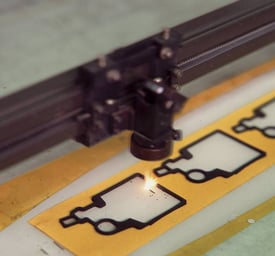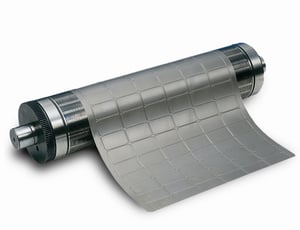Prototypes are typically produced in relatively small quantities and used by our customers to verify design, evaluate material choices, and build prototypes of their assembly.
When provided with a CAD file (.dxf format is best) along with information about the part, we can often times produce prototypes within 24 to 48 hours if using stock materials.
We offer various production methods to produce prototype parts. Marian’s sales engineers and production engineers collaborate to get a full understand of all the details related to the prototype request. Once given all necessary information, they determine the most fitting production method.
To give you a peek into this decision process, this blog post explores several of our prototype production methods, explaining the advantages and disadvantages of each.
Digital Cutting with Laser, Waterjet, and Plotters

With a two-dimensional CAD file (.dxf format is best), we can import the file to a computer program and are able to cut parts the same day with lasers, waterjet, and plotter cutting systems.
Using one of these methods, we avoid tooling costs and are able to move very quickly. If materials are stocked and readily available, we can ship an initial small order of prototypes the next day. Keep in mind, we stock thousands of thin, flexible materials at our facilities.
The decision to use laser, waterjet, or the plotter depends on the following:
- the material
- the footprint (size) and geometry (complexity) of the part
- the dimensional tolerances required
Advantages of Laser, Waterjet, and Plotter cutting
- No initial tooling costs
- Very quick to begin producing prototype parts with in-stock materials
- Very simple and inexpensive to change a dimension or part geometry
- Easy and inexpensive to investigate variations in design
Disadvantages of Laser, Waterjet, and Plotter Cutting
- These methods are relatively slow in cutting each part when compared to rotary or flatbed die cutting. Essentially these cutting methods are “drawing” each part, one at a time.
- Typically, these methods are not as capable of tolerances as tight as hard tooling. However, in some cases we can hold very close tolerances with our lasers. Additionally, lasers are capable of cutting “macro dimensions” that are too small for soft tooling or hard tooling.
“Soft Tooling” to Produce Parts with Rotary and Flat Bed Die Cutting

In addition to the cutting methods discussed above, we can also build cutting dies to produce prototypes with rotary and flatbed die cutting. These might be chemical etched dies or steel-rule dies. Chem-etched dies can be made for flat-bed-punch-presses or for rotary presses. Steel-rule dies are made for flat-bed presses only.
Advantages of Prototyping using "Soft Tooling" with Rotary and Flat Bed Die Cutting
- Typically, less expensive than hard tooling
- Can be created relatively quickly (days, not weeks)
- Can achieve reasonably close tolerances
- The actual cutting process of each part is quicker than the digital cutting methods described above
Disadvantages of Prototyping using "Soft Tooling" with Rotary and Flat Bed Die-Cutting
- Although much less than hard tooling, there is still some initial expense for tooling (vs. no tooling costs with digital cutting)
- A few days are required to create the tool before cutting can begin. It may be longer depending on the geometry and complexity of the part to be cut.
- Chem-etched dies are limited to very thin materials. Thick or very hard materials may not cut properly and may require a steel-rule die.
- Unlike the digital cutting methods discussed above, even a slight dimensional change to the part means a completely new and different tool.
Why Marian for Your Rapid Prototypes?
Marian’s sales engineers and production engineers are trained in all of these prototyping methods, understanding the strengths and limitations of each, and they will determine the best prototyping method and controls for your specific application.
When you need prototypes and need them quickly, contact Marian for help. You can complete the form “Prototype Part Request” and submit a sketch, drawing, or CAD file. One of our sales engineers will get in touch with you the same or next day. Or simply give us a call. We are ready to help.




